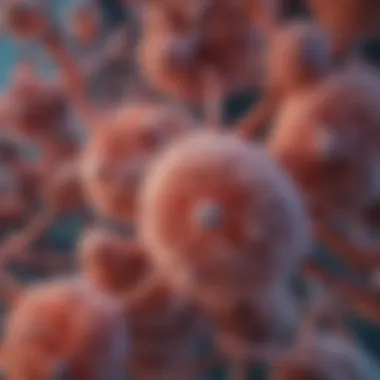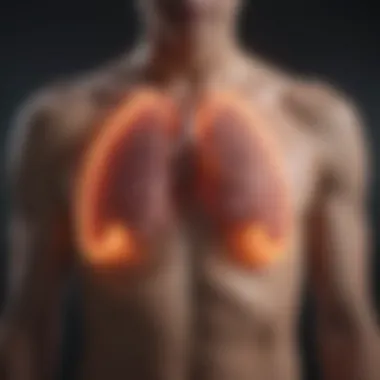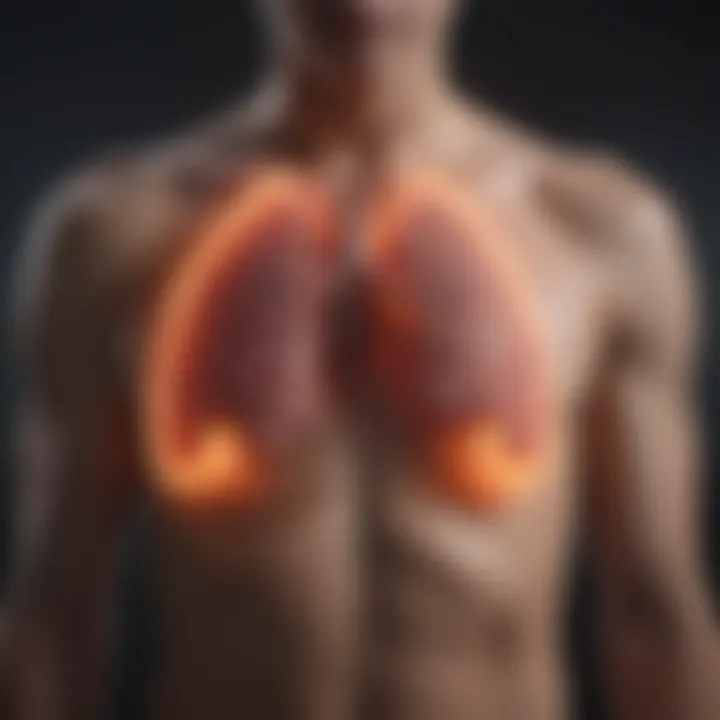Understanding Lung Cancer Types in Non-Smokers


Intro
Lung cancer is often associated with smoking. However, the reality is more complex, as non-smokers can also develop this disease. Understanding the types of lung cancer that manifest in this population is crucial for effective diagnosis and treatment. The unique characteristics of lung cancer in non-smokers raise several questions about its etiology, risks, and management. This article will provide an in-depth analysis of lung cancer types in non-smokers, exploring the biological mechanisms, risk factors, diagnostic challenges, treatment options, and latest research findings.
Methodology
Overview of Research Methods Used
The study of lung cancer in non-smokers primarily employs a combination of observational and analytical research methods. Various databases contribute to identifying cases that fall outside the smoker demographic. Epidemiological approaches help underline correlations between lung cancer and different environmental or genetic risk factors. The research also involves systematic reviews of existing literature to collect extensive data on histological types and clinical presentations.
Data Collection Techniques
Data collection relies heavily on patient registries, cohort studies, and case-control studies focused on non-smokers. These methods gather critical information on the clinical outcomes, treatment responses, and demographic data of affected individuals. Furthermore, laboratory research plays a central role, utilizing biopsies to identify specific histological classifications of tumors. Through these techniques, the scientific community gains a clearer understanding of how lung cancer develops in individuals who have never smoked.
Lung cancer in non-smokers primarily presents in two main histological types: adenocarcinoma and squamous cell carcinoma.
Adenocarcinoma
Adenocarcinoma is the most common type seen in non-smokers. It arises from the glandular tissues and is typically found in the outer regions of the lungs. This type is often linked to factors such as exposure to radon gas, air pollution, and certain occupational hazards. The prognosis can vary significantly, influenced by the stage at diagnosis and the presence of specific genetic mutations.
Squamous Cell Carcinoma
Squamous cell carcinoma is less prevalent among non-smokers. It usually originates in the central airways and is often associated with prior lung diseases. Although traditionally associated with smoking, its occurrence in non-smokers is increasingly recognized due to exposure to industrial pollutants and asbestos.
Important: The presence of specific molecular markers may assist in differentiating between lung cancers in smokers and non-smokers, highlighting the distinct biological behavior of the disease.
Notable Risk Factors
Apart from smoking, several notable risk factors contribute to lung cancer in non-smokers. Key influences include:
- Genetic predisposition: Familial history may increase risk.
- Exposure to secondhand smoke: Passive smoking remains a significant concern.
- Environmental toxins: Inhalation of harmful substances such as asbestos or radon.
- Air pollution: Long-term exposure to polluted air is a growing issue.
Diagnostic Challenges
Diagnosing lung cancer in non-smokers poses unique challenges. Symptoms may often be mistaken for other respiratory conditions. The complexity in the histological classification requires advanced imaging techniques and often necessitates a multi-disciplinary approach. Timely diagnosis remains critical for improved patient outcomes.
Treatment Options
Treatment for lung cancer in non-smokers varies based on histological type and disease stage. Typical options include:
- Surgery: Resection is common for early-stage tumors.
- Radiation therapy: Used as a primary or adjunct modality.
- Chemotherapy: Provides systemic control for advanced cases.
- Targeted therapy: Utilizing genetic profiling to tailor treatments.
Future Directions
Upcoming Trends in Research
Emerging research into lung cancer in non-smokers emphasizes the need for innovative treatment approaches, particularly around genetic and molecular profiling. Discovering specific genetic mutations can lead to targeted therapies.
Areas Requiring Further Investigation
More studies are needed to unravel the complexities of lung cancer development in non-smokers. Identifying environmental triggers and exploring preventive strategies will play an essential role in future interventions. The ongoing evolution of diagnostic tools must also be a priority to better aid this vulnerable demographic.
Understanding the types and characteristics of lung cancer in non-smokers is an essential endeavor for enhancing awareness and improving clinical practice. The journey towards a deeper understanding continues to unfold as research progresses.
Prolusion to Lung Cancer
Lung cancer is a significant health issue that affects millions globally. It is imperative to understand this topic, particularly because a considerable proportion of lung cancer cases occur in non-smokers. Recognizing the nuances of lung cancer in non-smokers is critical for developing targeted prevention strategies and informing treatment protocols. This article aims to shed light on the distinct types of lung cancer that can manifest in individuals without a history of smoking, thereby emphasizing the importance of awareness and research in this field.
The significance of this subject lies in the growing recognition that lung cancer is not solely a consequence of tobacco use. In fact, many patients diagnosed with lung cancer have never smoked. This reality challenges previous misconceptions and shifts the focus towards understanding alternative risk factors and biological mechanisms. Furthermore, exploring this topic can contribute to better diagnostic techniques and improve outcomes through more personalized treatment options for non-smoking patients.
Understanding Lung Cancer
Lung cancer primarily derives from the abnormal growth of cells in the lungs, leading to the formation of tumors. These tumors can disrupt normal lung function, affecting respiration and overall health. According to broad medical categorizations, lung cancer is mainly classified into two types: non-small cell lung cancer and small cell lung cancer. Each category consists of distinct histological types that will be discussed in detail later.
In recent years, research has revealed that the pathophysiology of lung cancer in non-smokers might be influenced by several factors, including genetic mutations, environmental exposures, and inflammatory processes.
- Genetic predisposition plays an essential role in some patients, indicating that family history can increase risk even in non-smokers.
- Environmental exposures, such as radon and asbestos, also present significant threats.
- Understanding these elements is vital for comprehensive prevention strategies.
This knowledge is essential for both practitioners and patients, as it lays the groundwork for discussions about risk factors and testing methods.
Global Statistics on Lung Cancer
Lung cancer ranks among the leading causes of cancer-related deaths worldwide. According to the World Health Organization, an estimated 2.2 million new cases were recorded in 2020 alone. What is concerning is that a notable proportion of these cases were in individuals who have never smoked.
Key statistics demonstrate the severity of this issue:
- Approximately 25% of lung cancer cases are diagnosed in non-smokers, suggesting a need for heightened awareness.
- The survival rate over five years for lung cancer patients remains relatively low, particularly for those diagnosed at later stages.
"Understanding the statistical landscape of lung cancer can illuminate trends in diagnosis and treatment, helping healthcare providers to tailor their approach."
These statistics highlight the urgency of specific research and education regarding lung cancer in non-smokers. This information propels discussions about the need for better diagnostic tools, preventive measures, and effective treatment modalities in the non-smoking population.


Epidemiology of Lung Cancer in Non-Smokers
Understanding the epidemiology of lung cancer in non-smokers is crucial for multiple reasons. First, it sheds light on the incidence and distribution of lung cancer among those who do not smoke, an aspect often overshadowed by smoking-related cases. This awareness enables researchers, healthcare professionals, and policymakers to formulate strategies and interventions targeted at high-risk populations.
Second, it provides insights into the underlying causes and environmental factors that may contribute to lung cancer in non-smokers. Recognizing these factors is essential for prevention efforts. Furthermore, as the profile of lung cancer patients evolves, continuing research into the epidemiology of this disease helps keep medical practitioners and the public informed.
Prevalence and Incidence Rates
The prevalence and incidence rates of lung cancer in non-smokers have garnered increasing attention in recent studies. According to recent data, non-smokers account for about 10-25% of all lung cancer cases. The variation in these percentages hinges on geographic regions, genetic factors, and environmental exposures. For instance, in some Asian countries, an even higher proportion of lung cancer cases is reported among non-smokers.
In non-smokers, adenocarcinoma is the most frequently diagnosed type of lung cancer. The notable increase in lung cancer among non-smokers particularly in women suggests a need for better understanding and research on risk factors affecting this group. Incidence rates can reflect how certain populations are affected and can help identify vulnerable groups that require focused health initiatives.
Demographic Factors
Demographic factors play a vital role in understanding lung cancer among non-smokers. These include age, gender, race, and socioeconomic status. Research indicates that lung cancer in non-smokers tends to occur more frequently in younger individuals compared to their smoking counterparts.
Women, particularly, have shown significant incidence rates. Studies reveal that factors like hormonal changes and genetic predispositions influence the development of lung cancer among women who have never smoked.
Moreover, racial and ethnic variations are evident, where certain demographic groups face higher risks due to environmental or genetic factors. Socioeconomic status also influences exposure to carcinogens like passive smoke, indoor air pollutants, and occupational hazards. Understanding these demographic nuances provides a more comprehensive picture of the lung cancer landscape, enabling more effective public health strategies.
Adenocarcinoma
Adenocarcinoma is the most common type of lung cancer found in non-smokers. This subtype originates in the glandular cells and typically occurs in the outer regions of the lungs. It is often associated with certain genetic mutations. Patients may experience a gradual onset of symptoms, which can include coughing, weight loss, and shortness of breath. Early detection of adenocarcinoma can be difficult due to its often subtle symptomatology.
It’s notable that adenocarcinoma tends to present more frequently in women and can occur at a younger age compared to other lung cancers.
The diagnosis of adenocarcinoma is usually confirmed through imaging studies followed by a biopsy. Treatment may involve a combination of surgery, chemotherapy, and targeted therapy, especially for individuals with specific genetic alterations. Its relatively high prevalence among non-smokers underscores the need for increased awareness and research focus on this subtype.
Squamous Cell Carcinoma
Squamous cell carcinoma, another significant subtype, typically arises from the epithelial cells lining the airways. Though historically linked to smoking, it is increasingly recognized in non-smokers, often related to environmental and genetic factors. The tumor commonly develops in the central parts of the lungs and is characterized by symptoms such as persistent coughing and chest pain.
Patients with squamous cell carcinoma may benefit from earlier diagnosis due to the more pronounced symptoms. The treatment regimen generally includes surgical options if the disease is localized. For advanced cases, a combination of chemotherapy and radiation therapy may be employed. Understanding the specific characteristics and treatment strategies for squamous cell carcinoma is crucial, especially as the landscape of lung cancer research continues to evolve.
Large Cell Carcinoma
Large cell carcinoma is a less common but aggressive form of lung cancer that can occur in non-smokers. This subtype can affect any part of the lung and generally has a poorer prognosis due to its fast growth rate. Notably, symptoms may present at an advanced stage, complicating early detection and treatment efforts.
The treatment plan for large cell carcinoma typically includes chemotherapy, and depending on the stage and spread of the disease, surgery may also be considered. This type of lung cancer often requires a proactive treatment approach due to its aggressive nature. As research advances, uncovering details related to biomarkers and genetic predispositions associated with large cell carcinoma will become increasingly important.
Small Cell Lung Cancer
Small cell lung cancer is rarer among non-smokers but remains significant due to its aggressive behavior and tendency to metastasize early. This type is most often linked to heavy smoking but also occurs in non-smokers, particularly those exposed to hazardous environments. Symptoms may include a severe cough, weight loss, and unusual fatigue.
The treatment for small cell lung cancer usually involves a combination of chemotherapy and radiation. It is crucial to recognize the urgency of treatment as this type has a tendency to progress rapidly.
Risk Factors for Lung Cancer in Non-Smokers
Understanding the risk factors for lung cancer in non-smokers is vital as it sheds light on this significant health issue. Many people are unaware that lung cancer can develop in individuals who have never smoked. Identifying these risk factors can help in prevention and early detection. The section outlines various elements that contribute to lung cancer, emphasizing that lifestyle choices, genetic vulnerabilities, and environmental exposures can all play a critical role in the development of this disease in non-smokers.
Genetic Predisposition
Genetic predisposition refers to hereditary factors that may increase the likelihood of developing lung cancer. Specific gene mutations can heighten vulnerability to cancerous transformations in lung cells. For instance, mutations in the EGFR and KRAS genes have been observed frequently in lung cancers among non-smokers. Understanding these genetic factors provides insights into the personalization of treatment options and can guide screening practices for at-risk individuals. When family history of lung cancer is noted, individuals may need more regular monitoring.
Environmental Exposures
Environmental factors are significant contributors to lung cancer in non-smokers. These can include various elements such as radon gas, asbestos fibers, and prevailing air pollution levels. Each of these factors exerts its influence in distinct ways.
Radon Exposure
Radon exposure is particularly critical as it is a natural radioactive gas that can accumulate in homes. It is crucial to recognize that radon is colorless and odorless, making it difficult to detect without testing. This exposure is the second leading cause of lung cancer after smoking. Homes built on soil rich in uranium are susceptible to higher radon levels. Testing for radon and mitigating exposure through proper ventilation can be effective in reducing lung cancer risk. This article highlights radon exposure as a key environmental concern that necessitates awareness and action.
Asbestos Exposure
Asbestos exposure, though regulated now, can still be an issue as it was commonly used in construction materials. Asbestos fibers, when inhaled, can lead to a specific type of lung cancer known as mesothelioma. This cancer is particularly aggressive and can take decades to develop after exposure. While past regulations have decreased current risks, older buildings can still present dangers. Highlighting the dangers of asbestos exposure is important for historical and ongoing health concerns in non-smokers.
Air Pollution
Air pollution is another dominant environmental risk factor associated with lung cancer. Fine particulate matter from vehicle emissions, industrial discharges, and other sources contribute to increased lung cancer risk. Studies show a clear connection between prolonged exposure to high levels of particulate matter and a variety of health issues, including lung cancer. Addressing air pollution at community levels can play a significant role in reducing risk factors for lung cancer. Understanding the complexities of air pollution helps raise awareness about public health and informs governmental policies.
Secondhand Smoke
Secondhand smoke remains a notable risk factor for lung cancer among non-smokers. Individuals exposed to smoke from others, particularly in crowded or poorly ventilated spaces, may be at an increased risk of developing lung cancer. Regulatory measures to prevent smoking in public spaces are essential for protecting non-smokers. Addressing this societal issue can not only improve health outcomes but also mitigate the broader implications of tobacco exposure and its impact on public health.
Occupational Hazards
Occupational hazards also contribute to lung cancer risk in non-smokers. People working in industries such as construction, mining, or chemical manufacturing may be exposed to carcinogens like arsenic, chromium, or diesel exhaust. This exposure necessitates strict workplace safety measures, which can help in reducing lung cancer rates among workers. Emphasizing safety training and protective equipment is vital to preventing occupational lung cancers.
By investigating these diverse risk factors, we can better understand the complexities of lung cancer in non-smokers. This knowledge is essential for preventive strategies and underscores the need for ongoing research and public health initiatives.
Biological Mechanisms of Lung Cancer Development


Understanding the biological mechanisms of lung cancer development is crucial because it helps to elucidate how the disease occurs in non-smokers. While smoking is a well-known risk factor, non-smokers can still develop lung cancer through various biological processes. Research focusing on these mechanisms opens paths for targeted therapies and early interventions. The insights gained from examining these mechanisms provide valuable information for both treatment and prevention strategies. This section addresses three key areas: the cellular pathways involved, the role of mutations and genetic alterations, and the influence of inflammation on cancer progression.
Cellular Pathways Involved
Cellular pathways are networks of molecules in cells that work together to transform a signal from outside the cell into a functional response. For lung cancer, several specific pathways have been identified as playing roles in its development. The most studied include the epidermal growth factor receptor (EGFR) pathway and the phosphoinositide 3-kinase (PI3K) pathway.
- EGFR pathway: This pathway is critical for cell division and survival. Mutations in EGFR can lead to uncontrolled cell growth, a hallmark of cancer.
- PI3K pathway: This pathway influences cell growth, proliferation, and survival. Alterations in PI3K signaling can contribute to tumor growth and resistance to therapy.
Both pathways have been found active in many adenocarcinoma cases among non-smokers. Understanding these pathways and their interactions helps develop targeted drugs that can inhibit these processes.
Mutations and Genetic Alterations
Genetic mutations are changes to the DNA sequence that can lead to cancer. In non-smokers, specific mutations are often identified in genes such as TP53, KRAS, and STK11. Each of these genes plays a different role in cellular function:
- TP53: A tumor suppressor gene that, when mutated, loses the ability to regulate the cell cycle.
- KRAS: Oncogene mutations are common in lung cancers and lead to abnormal cell signaling that promotes growth.
- STK11: This gene is linked to cellular metabolism and, when altered, can affect the cellular environment and promote cancer development.
These mutations often arise from environmental exposures like radon or pollutants. The detection of these mutations can guide treatment options and prognostic evaluations.
Role of Inflammation
Inflammation significantly contributes to the development of lung cancer in non-smokers. Chronic inflammation can create an environment conducive to cancer. For instance, inflammation can lead to increased production of reactive oxygen species (ROS), which can damage DNA and promote mutations. Factors contributing to chronic inflammation include:
- Air pollution: Fine particulate matter can enter lungs, leading to persistent inflammation.
- Chronic respiratory diseases: Conditions such as asthma and chronic obstructive pulmonary disease (COPD) create ongoing inflammation, increasing cancer risk.
- Viral infections: Certain viral infections like Epstein-Barr virus have been linked to lung cancer cases.
It is essential to grasp how inflammation interacts with genetic factors and cellular pathways to develop preventive strategies.
Understanding these biological mechanisms is imperative in creating tailored therapies for non-smokers with lung cancer, highlighting that the disease is not limited to those who smoke.
The comprehension of the biological mechanisms associated with lung cancer development in non-smokers promotes a nuanced understanding of the condition. This knowledge can drive innovation in both research and treatment, benefiting a wider spectrum of patients.
Symptoms and Diagnostic Challenges
Understanding the symptoms and diagnostic challenges associated with lung cancer in non-smokers is critcal for early detection and treatment. Many signs of lung cancer can mimic common respiratory illnesses, which may lead to a delay in diagnosis. Addressing this is essential because even non-smokers can develop aggressive forms of lung cancer, often resistant to standard treatments. Awareness of symptoms may enable timely interventions, improving patient outcomes. Here, we delve into the common symptoms, diagnostic techniques, and the associated challenges that healthcare providers face during the diagnostic process.
Common Symptoms of Lung Cancer
Lung cancer symptoms are often subtle and can be easily overlooked. Non-smokers may experience symptoms similar to those in smokers, but they may attribute these signs to other factors. Common symptoms include:
- Persistent cough that does not go away
- Shortness of breath or wheezing
- Chest pain that may be sharp or dull
- Unexplained weight loss
- Fatigue and weakness
- Coughing up blood or rust-colored sputum
These symptoms can often be associated with conditions like asthma or chronic obstructive pulmonary disease (COPD), making it challenging to distinguish lung cancer. Familiarity with these symptoms can enhance vigilance and encourage individuals to seek medical evaluation early.
Diagnosis Techniques
Diagnosing lung cancer in non-smokers requires a combination of advanced imaging and procedural methods.
Imaging Tests
Imaging tests play an essential role in identifying tumor locations and sizes. Techniques such as low-dose computed tomography (CT) scans are commonly used for lung cancer diagnosis. The key characteristic of imaging tests is their ability to visualize structures within the lungs in great detail.
These tests are effective because they can detect abnormalities that might not be visible in regular X-rays. One unique feature is the use of CT scans to assess lung nodules, which can be indicative of early-stage lung cancer. However, there are some disadvantages, including the risk of over-diagnosis and possibly exposing patients to unnecessary radiation.
Biopsy Procedures
Biopsy procedures are another critical step in clarifying a lung cancer diagnosis. The process involves obtaining tissue samples for pathological evaluation. The key characteristic of biopsy procedures is their reliance on histological examination to confirm the presence of cancer. This method is favored because it provides definitive information about the cellular nature of a tumor.
A unique feature of biopsies is the variety of techniques available, such as bronchoscopy or needle biopsies, which allow for minimally invasive sampling. One advantage of these approaches is their potential to be performed with sedation or local anesthesia, reducing patient discomfort. However, some disadvantages may include complications, such as bleeding or pneumothorax, which, although rare, can occur during the procedure.
Challenges in Diagnosis
The diagnostic process for lung cancer in non-smokers faces several challenges. One major issue is the lack of specific symptoms, which can lead to misdiagnosis or delayed treatment. Physicians often have to rely on imaging and biopsy results, which can also be influenced by the location and size of the tumor.
Additionally, healthcare practitioners may face biases or assumptions about who is at risk for lung cancer. Thus, both patients and doctors need to maintain a high level of awareness and consideration for lung cancer, regardless of smoking history. This acknowledgment can assist in addressing the false sense of security surrounding non-smokers and ensure proactive health measures.
Treatment Options for Lung Cancer in Non-Smokers
Understanding the treatment options available for lung cancer in non-smokers is vital. This section aims to elaborate on the diverse methods that can be utilized to tackle this disease. While lung cancer in non-smokers can present unique challenges, advanced treatment modalities are able to significantly influence outcomes. An individualized approach is often required, depending on the specific type of lung cancer and its progression. Let’s explore these treatment options in detail.
Surgical Interventions
Surgical interventions can be a critical line of defense against lung cancer. The goal is to remove cancerous tissues and, potentially, surrounding lymph nodes to prevent further spread. Depending on several factors such as tumor size and location, procedures may vary.
- Lobectomy: This involves removing a lobe of the lung and is one of the most common surgical options.
- Pneumonectomy: In cases where the cancer is more extensive, a complete lung may need to be removed.
- Wedge Resection: This option allows for the removal of a small, wedge-shaped section of lung containing the tumor.
Surgery is often considered when cancer is detected at an early stage and has not metastasized. Recovery from surgical procedures can be significant, so discussing potential risks and benefits with healthcare professionals is crucial.
Radiation Therapy
Radiation therapy employs high-energy rays to target and damage cancer cells, inhibiting their ability to grow and divide. This method may be used as a primary treatment or as an adjunct to surgery.
- External Beam Radiation Therapy (EBRT): This is the most common form, where radiation is directed from outside the body towards the tumor.
- Stereotactic Body Radiotherapy (SBRT): A highly precise radiation treatment that delivers high doses to tumors while sparing healthy tissue.


Radiation therapy can also relieve symptoms in advanced cancer cases, making it a versatile option. Patients may experience side effects such as fatigue and skin reactions, which should be monitored throughout treatment.
Chemotherapy and Targeted Therapy
Chemotherapy involves the use of drugs to kill or impede the growth of cancer cells. It can be administered before surgery to shrink tumors or after to eliminate remaining cancer cells. Different chemotherapy regimens may be applied depending on the type of lung cancer diagnosed.
Targeted therapy offers a more specific approach, focusing on molecular targets associated with cancer. This may be particularly important for non-smokers, as certain genetic mutations linked to lung cancer are often found in individuals who have not smoked.
- Common Chemotherapy Drugs Include:
- Examples of Targeted Therapies:
- Cisplatin
- Carboplatin
- Docetaxel
- Erlotinib for EGFR mutations
- Crizotinib for ALK rearrangements
The choice between chemotherapy and targeted therapies depends on individual cancer characteristics, underscoring the importance of precise diagnosis.
Immunotherapy Approaches
Immunotherapy is an emerging treatment that harnesses the body's immune system to fight cancer. This approach can be particularly useful for non-smokers, as their tumors may exhibit unique immune responses.
- Checkpoint Inhibitors: Drugs that block proteins preventing immune cells from attacking cancer, such as pembrolizumab and nivolumab.
- CAR T-cell Therapy: A cutting-edge technique that modifies a patient’s T cells to more effectively target cancer cells.
Immunotherapy can result in durable responses in some patients but is not suitable for all types. Careful selection of candidates based on genetic and molecular profiling is essential.
"As research progresses, new combinations of treatment options are continuously being explored to enhance efficacy and minimize adverse effects."
Prognosis and Survival Rates
Understanding the prognosis and survival rates in lung cancer cases among non-smokers is vital for multiple reasons. It helps clinicians make informed decisions about treatment options, sets realistic expectations for patients and families, and contributes to the ongoing research in this field. Prognosis refers to the likely course and outcome of the disease, encompassing the chances of recovery and the potential for recurrence. Statistics regarding survival rates offer a glimpse into the effectiveness of different treatments and underscore the need for targeted therapeutic approaches for non-smokers.
Factors Influencing Prognosis
Prognosis in lung cancer patients, especially those who have never smoked, can be influenced by several factors:
- Stage at Diagnosis: Early-stage lung cancer generally correlates with better prognosis compared to advanced stages. The TNM classification system (Tumor, Node, Metastasis) plays a significant role in determining staging and subsequent outcomes.
- Histological Type: Different types of lung cancer, such as adenocarcinoma or small cell lung cancer, have distinct biological behaviors that impact survival. For instance, adenocarcinoma tends to have a better prognosis than small cell lung cancer.
- Genetic Alterations: Specific mutations, such as those in the EGFR (Epidermal Growth Factor Receptor) or ALK (Anaplastic Lymphoma Kinase) genes, can dictate therapeutic responses and affect overall prognosis.
- Age and Overall Health: Younger patients and those with fewer comorbidities generally exhibit better survival rates. Factors like general health, nutritional status, and mental well-being contribute to resilience during treatment.
- Response to Treatment: How a patient responds to treatments like chemotherapy or immunotherapy can significantly alter their prognosis. Monitoring treatment efficacy can inform necessary adjustments in strategy.
"Prognosis focuses on the potential outcomes of a disease. For non-smokers, understanding these can be a pivotal aspect of making informed health decisions."
Comparative Survival Rates
Comparative survival rates are typically expressed as a 5-year survival percentage, indicating how many patients are alive five years after their diagnosis. For lung cancer in non-smokers, survival rates may differ significantly compared to smokers. For instance, research shows that non-smokers may experience markedly improved survival rates, often reporting figures between 40% to 60% at five years, depending on cancer stage and type. In contrast, the survival rate for smokers can be significantly lower, sometimes dropping to below 20%.
Several key insights emerge regarding comparative survival rates:
- Stage-Specific Rates: Survival rates increase substantially for those diagnosed at an early stage (Stage I), potentially exceeding 70%, while the rates drop dramatically for late-stage diagnoses.
- Impact of Early Detection: With advancements in screening techniques, such as low-dose CT scans, there is potential for improved early detection, which can enhance survival rates.
- Influence of Treatment Advances: The emergence of targeted therapies and immunotherapies has positively influenced survival rates among non-smokers, as these options may allow for more effective and personalized treatment regimes.
- Overall Trends: Continuous research and clinical trials underscore an upward trend in survival rates for lung cancer, driven by innovations in both treatment and early detection strategies.
In summary, prognosis and survival rates are critical components in understanding lung cancer among non-smokers. Evaluating these factors contributes to a more precise comprehension of disease patterns and treatment efficiency, ultimately aiding in enhancing patient care and outcomes.
Future Directions in Research
The exploration of lung cancer in non-smokers has become increasingly vital due to the significant impacts of this disease on public health. With lung cancer traditionally associated with smoking, it is crucial to investigate the mechanisms and factors that contribute to its development in non-smokers. Research in this area can lead to enhanced understanding and more effective prevention strategies.
In recent years, there has been a growing recognition of unique histological types of lung cancer, specifically prevalent among non-smokers. Advances in academic research are key in identifying the differences in tumor biology between smokers and non-smokers. This understanding can drive therapeutic advancements tailored to this population.
Emerging Biomarkers
Emerging biomarkers hold immense potential in lung cancer research, particularly for early detection and personalized treatment. Biomarkers such as genetic mutations can serve as indicators of lung cancer predisposition. Recent studies have focused on specific gene alterations like EGFR, ALK, and ROS1, which have been observed in adenocarcinoma cases common among non-smokers.
Identifying these biomarkers may facilitate the development of targeted therapies, ensuring that treatments are more effective and less toxic.
"Incorporating biomarker studies can lead to more accurate diagnosis and better outcomes for patients diagnosed with lung cancer."
Advances in Precision Medicine
Precision medicine is another front where lung cancer research is headed. This approach customizes healthcare, tailoring treatment strategies based on patients' individual characteristics, such as their genetic profile or specific tumor characteristics. For non-smokers, precision medicine can be transformative.
Recent progress has highlighted how targeted therapies can improve survival rates significantly. For instance, patients with specific mutations may benefit from drugs like osimertinib or crizotinib, which are designed to inhibit the pathways that drive tumor growth. Through such advancements, treatments can be optimized, reducing unnecessary side effects and enhancing efficacy for non-smokers.
Overall, the future of lung cancer research, especially concerning non-smokers, is promising. By focusing on the unique biological and genetic aspects of this demographic, researchers can pave the way for innovations that not only improve treatment but also enhance survival rates significantly.
Epilogue
The topic of lung cancer in non-smokers deserves significant attention within the medical and research communities. This article clarifies the distinct types of lung cancer prevalent among individuals who have never smoked. Understanding these variations is crucial for effective diagnosis, treatment, and public health strategies.
Summary of Key Findings
In evaluating the content of this article, several key findings emerge:
- Types of Lung Cancer: Non-smokers can experience various forms of lung cancer, primarily adenocarcinoma. This subtype is often associated with genetic factors and environmental exposures rather than smoking.
- Risk Factors: Genetic predisposition, exposure to environmental toxins, and factors like secondhand smoke have been identified as significant contributors to developing lung cancer in non-smokers.
- Biological Mechanisms: Understanding the underlying mechanisms, including mutations and inflammation, provides insights into how non-smokers can develop this disease.
- Diagnostic Challenges: The symptoms of lung cancer can be vague and easily mistaken for other conditions, complicating early detection in non-smokers.
- Treatment Options: A range of treatment modalities exists, from surgical options to targeted therapies, which can be particularly effective based on the cancer’s type and stage.
Implications for Public Health
The findings in this article have several implications for public health. First, they highlight the urgent need for increased awareness of lung cancer in non-smokers. Health campaigns should focus on educating the public regarding risk factors and symptoms to promote early detection.
Furthermore, healthcare professionals must improve knowledge about the variations of lung cancer that occur in non-smokers. This can aid in more accurate diagnoses and tailored treatment approaches.
In addition, continual research into environmental exposures and genetic predispositions is vital. Identifying potential risk factors and biomarkers can help in developing targeted prevention strategies. Ultimately, addressing lung cancer in non-smokers is not merely a clinical concern but a public health imperative that requires coordinated efforts across disciplines.







